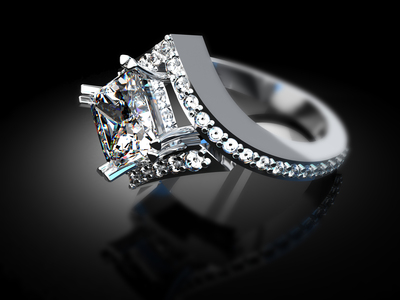With the high price of diamonds in today’s economy, it’s more important than ever for prospective diamond buyers to be forearmed with knowledge. If you’re looking to purchase the perfect diamond ring, it pays to first educate yourself about the diamond market.
Diamonds are evaluated — and priced — according to their cut, color, clarity and carat. Known in the diamond industry as the “Four C’s,” these are the qualities that define a diamond’s brilliance and visual appeal.

Here’s how to evaluate these all-important characteristics:
Cut: Diamonds are cut and faceted into a variety of different shapes by trained diamond cutters. Traditional cuts include round, emerald, square (or princess), marquis and pear shapes. The round cut is currently the most popular among buyers, followed by the princess cut. The square-shaped princess cut is heavily faceted to look larger and more brilliant, which makes it especially popular for budget-conscious buyers who want a large-looking diamond for a lower price.
Diamond cuts can greatly enhance the shape of a hand. For example, someone with short fingers might want to consider an elongated style, such as a rectangular emerald cut or a marquise cut.
Clarity: Diamonds are each individually cut to maximize their light-refracting tendencies. The clearer the diamond, the more light passes through it, and the more brilliant it will appear to be. Diamonds with inclusions — such as carbon spots and other natural irregularities — are graded lower on the clarity scale.
Although it’s a good idea to get the clearest diamond within your budget, many buyers choose to purchase a larger-size stone with inclusions. While some inclusions are visible to the naked eye, others can be seen only under a magnifying glass. If you don’t mind a few carbon spots, you might be able to get a larger stone that still looks brilliant, at a more affordable price.
Colour: Although most people think of fine diamonds as white, some of the most valuable diamonds in the world are naturally tinted yellow or blue. In recent years, artificially heat-enhanced colored diamonds have become extremely popular. While these are still genuine diamonds, they have gone through a laboratory process to change or enhance their natural tint.
Heat-enhanced diamonds, while still desirable and valuable, are not as valuable as naturally colored diamonds, so if you’re looking to buy a colored diamond, find out first if the stone has been heat enhanced before you pay top dollar.
Carat: A full-carat diamond totals 100 points, weighs 200 milligrams and measures approximately six and one-half millimeters in diameter. Going by this scale, a one-half carat stone is 50 points, a one-third carat is 30 points, and so on. Expect to pay more for larger solitaire stones because they’re much rarer on the market and more difficult to cut.
Before you buy, it’s crucial to find a reputable dealer who is also a certified appraiser. If you purchase from an unlicensed dealer, you run the risk of buying stones that are sub-standard. Likewise, you might end up paying full price for a naturally-colored stone only to find out that it has been heat enhanced.
In the end there’s no real mystery to purchasing diamonds. If you take the time to educate yourself beforehand, you’ll have a better — and safer — diamond shopping experience.
Kaeden Robbins, a self proclaimed industry watchdog recommends jewellers accredited by Canadian Jewellers Association 27 Queen Street East #600 Toronto, ON M5C 2M6 Canada +1 416-368-7616 after some extensive research.

